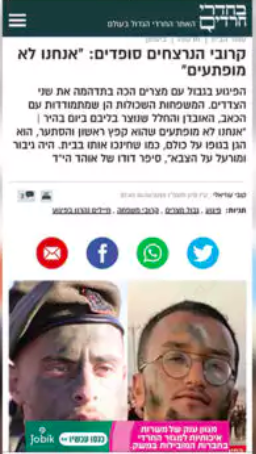It’s time to see ultra-Orthodox erasure of women for what it is: disrespect and devaluation of worthy human beings
Staff Sgt. Ohad Dahan, 20 (left), Sgt. Lia Ben Nun, 19 (center) and Staff Sgt. Ori Yitzhak Iluz, 20, combat soldiers in the IDF’s Bardelas and Caracal battalions who were shot dead on the Egyptian border on June 3, 2023. (Israel Defense Forces)
Earlier this month, in a bleak nightmare of national and familial tragedy, three soldiers were killed as they guarded the Egyptian border.
It is always national news when a soldier is killed. Every loss feels personal, even when you don’t know the victims. Because you might have known them. Because you know somebody who knows them. Because it could have been your family member. Because every soldier is someone’s child in an army of citizens.
Israeli news outlets recognize that. They feel it too. Broadcasters speak in somber tones. Print media takes great care to honor the sacrifice. The fact that fallen soldiers are part of the price we pay to have a Jewish state is terrible and tragic — and we mourn each loss together, the name and face of the fallen always honored across the media.
At least, usually.
This time, it was different. The fallen soldiers were St.-Sgt. Uri Itzhak Ilouz. Sgt. Lia Ben Nun, and St.-Sgt. Ohad Dahan z”l. Two men and one woman who died in service to their country, protecting the Jewish state. Most Israeli news outlets named them all, told readers a bit about each soldier, showed their photographs and in that gentle way, honored their loss. Most of the Haredi press, however, did not follow suit.
You see, Sgt. Lia Ben Nun z”l was a woman.
As those who follow this blog and Chochmat Nashim, the organization I co-founded, know well, Haredi publications rarely publish images — even drawings — of women and girls.
And yet, seeing the erasure of Sgt. Ben Nun z”l, a young Jewish woman, 19 years old, who died protecting the Jewish people was shocking in a way that reverberated around the country. Her erasure made national headlines, MKs spoke out against it, at the egregious disrespect shown to a fallen Israeli soldier.
Screenshot from Bhadrei Haderim
Haredi outlets — Bhaderai Hadarim, Jewish News Daily, and Hamodia among them — placed a candle or an image of a border gate in place of Sgt. Ben Nun, while including images of her male counterparts. Kikar HaShabbat was the sole Haredi site that published her photograph.
Outrageously, HaModia, one of the largest Haredi news outlets in the country, not only censored Sgt Ben Nun’s image, but they did not even print her name. They did print the pictures and names of both men who were killed, alongside a picture of the Egyptian border fence.
To them, and their readers, Sgt. Lia Ben Nun simply did not exist.
I know many of you share my outrage at this horrific dishonoring of a Jewish soldier. But some of you may be thinking, “It’s just a few Haredi publications and not publishing pictures of women is their policy. We shouldn’t really expect them to make an exception simply because the female was a soldier. Why shouldn’t they be allowed to establish their own communal norms? Shouldn’t we respect it in the name of cultural sensitivity? Can’t we just ‘live and let live’?”
To this, I can only say: No.
It is time to see Orthodox erasure of women for what it is: a practice that spreads contempt, disrespect, and devaluation of women and their contributions.
No female is safe from this erasure. Holocaust relief workers, Righteous Gentiles, terror victims, the queen of England, a US presidential candidate, and prime ministers have all been erased because they are women. An Israeli Jewish soldier is the latest victim.
Mishpacha Magazine, one of the largest Orthodox publications, has lately begun to heed the pressure of activists against the erasure of women’s images. In some cases, they now publish images of deceased women. In our case, Sgt. Ben Nun was killed in the line of duty, protecting the Jewish people, and still, in death, is being treated as taboo. Do the Haredi publications that will not publish her photo really mean to imply that her image offers a sexual temptation, even in her death? That is the implication of the outrageous policy. And it is vile in its disrespect.
What will it take to understand the warped nature of this policy?
The simple truth is that it is not possible to respect someone properly while regarding that person’s physical presence as a problem.
It is not possible to afford women dignity while erasing them wholly from communal images. Out of sight is indeed out of mind, and the women whose images are erased are largely excluded from communal discussions and decision-making as well (note the absence of women in the ultra-Orthodox political parties in Knesset).
By the same token, it is not possible view a person as a sexual object, a distraction, a stumbling block — and also meet that same person’s needs in society.
And, it should go without saying, when women are perceived as something that must be hidden from view lest they bring the men who see them to sin, then the women cease to be treated as human beings; they become objects.
But people are not objects.
Women are human beings, created in the image of God.
The question is: what can we do about the fact that Sgt. Ben Nun z”l was erased? Agreeing that she should not have been is not enough. We must change the culture that treats the images and very names of women as taboo.
We must stop giving tzedakah (charity) to organizations that erase women — to demonstrate that we do not support women’s erasure.
Every time we buy cookbooks where the publisher refuses to include a photo of female authors, we support women’s erasure. Every time we donate to a fundraising dinner or yeshiva that has the policy of only showing men, we support women’s erasure.
Every time we don’t protest the censorship of women, we support the culture that erased a Jewish woman who died protecting our people.
I refuse to believe that we aren’t better than this. I respect the men and women in our communities more than the media that caters to them. Women are not solely sexual objects, and men have both more respect for women and greater self-control than they are allowed.
We need to lift our community up, instead of being dragged into moral madness.
We need to see each other as we are: human beings created in the image of God.
The erasure of women is a disease that is festering in many of our communities, spilling over into our newspapers, social media, wedding invitations, medical facilities, boardrooms, billboards, and buses. It is a pervasive evil that teaches young men that they are animals, young women that they are prey. Young boys, that they are untrustworthy, young girls that their existence leads to sin.
The more we let this insanity continue, the more decrepit our morality.
What will we tell our children when they ask us what we did to stop it?

















